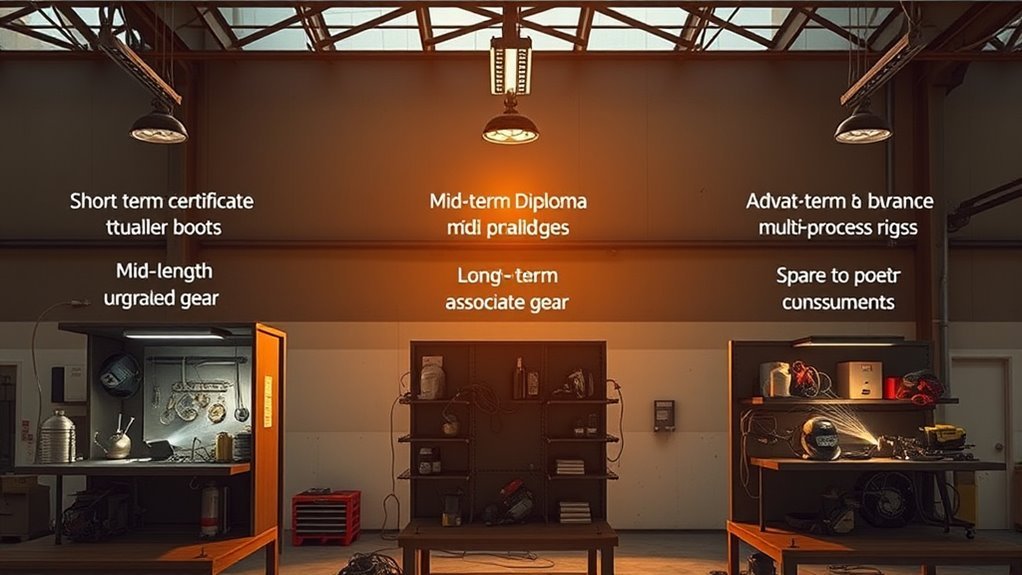You’ll typically pay about $250–$1,875 per month for welding school, depending on program length, credential level, and school type. Community college programs spread costs over two years and run toward the lower end, while short certificate or specialty courses raise monthly bills. Expect extra monthly costs for PPE, consumables, and living expenses. Scholarships, grants, and payment plans can lower what you actually pay each month. Keep going to see program-by-program examples and financing tips.
Average Monthly Tuition Breakdown for Welding Programs

On average, you can expect total welding program costs to land between $5,000 and $15,000, which breaks down to roughly $625–$1,875 per month for an 8‑month course.
Expect welding programs to cost about $5,000–$15,000 total — roughly $625–$1,875 per month for eight months
You’ll use a tuition comparison to pick the right fit: community colleges often run lower monthly rates (about $250–$625 if spread across a two‑year associate program), while certificate tracks typically cost $3,000–$10,000, or about $375–$1,250 per month over several months.
Advanced specialties like underwater welding can exceed $15,000, pushing monthly tuition toward $1,875 for similar program duration.
Compare total cost against how long you’ll study, then prioritize programs that match your timeline and budget so you don’t overcommit financially.
Additional Monthly Expenses: Gear, Materials, and Living Costs

Although tuition gets you into class, you’ll also pay monthly for gear, materials, and living expenses that can add several hundred dollars to your budget.
Expect safety gear and material costs to vary: personal PPE (boots, long pants, goggles) often runs $100–$500 initially, course supplies another $100–$500 monthly, and practice equipment like a welding machine can be $500–$2,000 if you finance it over time.
- PPE and safety gear: budget $100–$500 upfront, replace as needed.
- Material costs and supplies: plan $100–$500 monthly for consumables and books.
- Housing and living: room and board average $417–$1,250 monthly depending on location.
Prioritize essential safety gear first, then spread machine payments or extra materials across your budget.
Monthly Cost Differences by Program Type and Length

Because program type and length change how you pay, you should compare monthly costs as well as total tuition: short certificate programs pack higher monthly bills (often $375–$1,250) because you’re paying $3,000–$10,000 over weeks to months.
Diploma programs spread $5,000–$15,000 across about a year ($417–$1,250/month), community college routes dilute costs over longer terms (roughly $5,000 over two years, about $208/month), and advanced specialties like underwater welding can push monthly costs above $1,250 when the total exceeds $15,000 for a condensed timeline.
Use welding program comparisons to map costs to your schedule and goals. For financial planning, list program length, total tuition, and expected monthly outlay so you can choose the option that fits your budget and timeline.
How to Lower Your Monthly Payments: Aid and Financing Options

To lower your monthly payments, combine aid and flexible financing so the program you choose fits your budget. You can reduce tuition and monthly obligations by targeting scholarship opportunities from associations and companies, applying for federal grants that don’t require repayment, and choosing student loans with manageable repayment terms.
Combine scholarships, grants, and low-interest loans—plus school payment plans—to lower tuition and reduce monthly payments.
Use school payment plans to spread costs during training.
- Prioritize scholarships first to cut principal and monthly payment size.
- Add federal grants when eligible, then supplement with low-interest student loans.
- Use school payment plans for short-term cash flow while you finish the program.
Good financial planning means combining these sources strategically so you minimize total cost and keep monthly payments affordable without sacrificing program quality.
Estimating Return on Monthly Investment: Job Prospects and Earnings

1 key way to judge whether welding school fits your budget is to compare your monthly training cost to likely earnings after graduation.
Use these facts to estimate ROI: the average welder earns about $47,540 annually (roughly $3,962 monthly), while entry-level pay ranges from $13–$40 per hour depending on industry and location.
With a projected 6% job market growth through 2026, demand stays steady. Factor in that welding certifications boost hiring odds and can access specialized, higher-paying roles.
Calculate months to recoup tuition by dividing total program cost by expected net monthly income gain.
Also weigh long-term gains: experience plus additional certifications typically raise income over time, making reasonable monthly school payments a practical investment.
Frequently Asked Questions
Are Weekend Welding Classes More Expensive per Month?
Yes — weekend class pricing is often higher per month because fewer sessions increase overhead; you’ll pay more per hour. Consider class duration impact: shorter, concentrated weekends raise monthly rates compared with longer weekday schedules.
Do Online Welding Theory Courses Lower Monthly Costs?
Absolutely — you’ll usually save a ton: online course advantages include lower tuition, no commute, flexible scheduling, and cheaper materials, so a cost comparison shows reduced monthly expenses, though hands‑on labs may still add extra fees.
Is Equipment Insurance Included in Monthly Tuition?
Usually no—you’ll need separate equipment coverage; schools sometimes offer insurance options you can buy. Check program details and ask about school policies, third-party insurers, deductible amounts, and whether loaner gear or repair plans are included.
Are There Monthly Scholarship Programs for Welding Students?
Yes — you can find monthly scholarship programs for welding students. You’ll check scholarship eligibility, apply through school or trade organizations, and combine scholarships with financial aid to cover tuition, tools, and living expenses.
Can Employers Reimburse Monthly Training Expenses?
Yes — you can often get employer reimbursement for training expenses. Check company policies, submit receipts or invoices, confirm eligible courses, and ask about repayment caps, tax treatment, and required documentation before enrolling to guarantee coverage.
Conclusion
You’ll pay varying monthly amounts for welding school, but smart shopping saves cash. Scan school size, select shorter programs, seek scholarships or subsidized supplies, and split costs with part-time work. Picture practical progress: steady savings stacking, steady skills sharpening, steady salary soaring. With careful comparisons and cost-cutting choices, your monthly outlay becomes manageable, turning training-time tradeoffs into tangible trade wins — faster footing for a fulfilling, financially feasible fabrication future.


